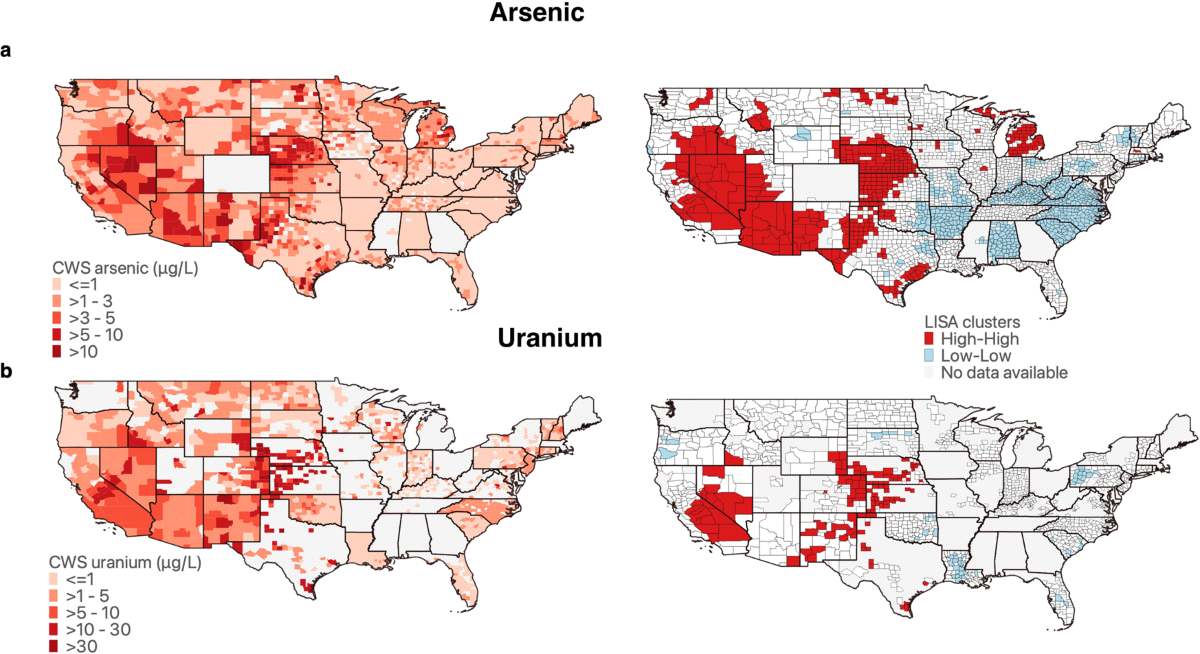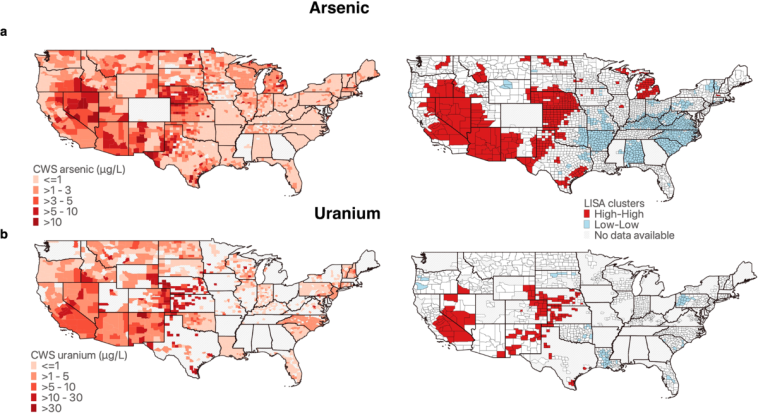
Examining America’s “Forever Chemicals” in Drinking Water
Americans have grown increasingly concerned by reports that “forever chemicals” known as PFAS have not only infiltrated drinking water sources across the country, but have also persisted in our environment. These chemicals, used for decades in consumer products such as nonstick cookware, waterproof clothing, and stain-resistant furnishings, are now at the center of a heated debate for their potential harm to public health. In this opinion piece, we take a closer look at the tangled issues surrounding PFAS contamination and the steps that need to be taken by communities, regulators, and industries alike.
The conversation about PFAS in water brings with it many tricky parts. Stakeholders—from environmental advocates to public health officials and industry representatives—are trying to find their way through the complicated pieces of scientific data, regulatory guidelines, and economic pressures. It is a topic full of problems, loaded with issues that affect not only our water quality but also our broader ecosystems and long-term public health outcomes.
Understanding the Danger Behind “Forever Chemicals”
PFAS, or per- and polyfluoroalkyl substances, are notorious for their persistence in the environment. Classified as a Group 1 carcinogen by the International Agency for Research on Cancer, PFAS are challenging because they do not break down naturally. The chemicals accumulate right back into our drinking water, irrigation systems, and even our food supplies.
Such a characteristic has transformed PFAS into a public health nightmare. The levels of PFAS contamination in many waterways have been found to exceed the maximum contaminant levels set by the Environmental Protection Agency (EPA). The fact that these chemicals build up over time—even at very low concentrations—underscores the nerve-racking threat they pose. Toxicologists and public health experts have linked long-term exposure to PFAS with a host of health issues including thyroid disease, kidney cancer, high cholesterol, and numerous other serious illnesses.
How PFAS Compare to Other Known Carcinogens
Unlike many other environmental toxins that only persist for a short period, PFAS are notorious for their longevity. These chemicals are aptly described as “forever chemicals” because they remain in the environment almost indefinitely. This persistence allows them to accumulate in the body over time, potentially leading to severe health problems even with minute exposure.
One of the critical challenges is the insufficient testing and measurement. Current technology only detects a small fraction—approximately 2 percent—of the PFAS present in water. As such, what we know might be just the tip of the iceberg in terms of both the number of compounds and their cumulative effects on human and environmental health.
Public Health Implications of PFAS Contamination
Public health officials warn that even low concentrations of PFAS in drinking water can have toxic effects on cells. Research indicates that chronic exposure through ingestion, inhalation, and even direct skin contact could amplify the risk of various ailments. Medical professionals have grown increasingly worried about vulnerable segments of the population, especially pregnant women and young children, who are at greater risk for adverse health effects such as developmental delays and immune system impairments.
This issue is not merely about individual health; it also places a tremendous burden on our healthcare systems. Over time, the cumulative health impacts of PFAS exposure could lead to an increase in treatment costs, loss of productivity, and long-term challenges for communities already coping with strained resources. The public health dialogue now requires that we address each of these complicated pieces with urgent and actionable strategies.
Linking PFAS Exposure to Broader Health Concerns
Experts from institutions like Purdue University and Northeastern University are stressing that the health implications of PFAS contamination extend far beyond isolated cases of cancer. They have suggested that PFAS chemicals have subtle effects on multiple body systems, which may lead to diseases that are traditionally not linked directly to chemical exposure. For instance, there is growing evidence to support associations between PFAS exposure and conditions such as ulcerative colitis, pregnancy-induced hypertension, and testicular cancer.
In community meetings and public hearings, these issues have emerged as central topics. Residents are not only demanding answers from regulatory bodies like the EPA but also seeking clear, actionable advice on how to reduce their exposure to these persistent chemicals. The complexity lies in the fact that PFAS are omnipresent in everyday products, making it nearly impossible for consumers to completely avoid them.
Regulatory Challenges and the Role of the EPA
The role of the EPA in controlling PFAS contamination is both critical and controversial. While the agency has set legally enforceable levels for some PFAS compounds—such as perfluorooctanoic acid (PFOA) and perfluorooctane sulfonic acid (PFOS)—there remains a significant gap in regulations covering the full spectrum of these chemicals.
Under the current guidelines, public water systems in the United States are required to monitor and report PFAS levels, with full compliance expected by 2029. However, critics point out that these measures may be too little, too late, given that many water sources already exceed the millions of miles of waterways contaminated. Some experts argue that the maximum contaminant limits set by the EPA are overly generous, given the documented evidence of health risks even at lower concentrations.
Assessing Current EPA Policies
The tangled issues lie in the EPA’s decision-making processes and the influence of both science and politics. For example, during the shift between administrations, there have been notable changes in the enforcement of PFAS regulation. While the Biden administration moved toward stricter enforcement and expanded guidelines, the previous administration rescinded some of those measures, leaving communities uncertain about the long-term regulatory picture.
These changes illustrate the nerve-racking toll that shifting political priorities can have on environmental safety standards. For many, the question remains: How effective can the EPA be if political pressures lead to inconsistent policies? The answer is not simple, but it is clear that a robust, consistent regulatory framework is essential for protecting public health.
Economic Impacts and Industrial Considerations
PFAS contamination presents not just health challenges but also significant economic dilemmas. Industries that have historically relied on PFAS-containing materials are now forced to reckon with the long-term consequences of their previous choices. For manufacturers and industrial producers, the presence of PFAS in water systems translates into costly clean-up efforts, potential fines, and reputational damage.
From an economic perspective, the remediation of PFAS can be seen as a double-edged sword. On one hand, there is an urgent need for financial investments in modern water treatment technologies to eliminate these contaminants effectively. On the other, those funds often originate from public coffers and are absorbed as higher taxes or water bills, adding to the economic strain experienced by families and businesses alike.
Financial Pressures on Local Communities
Regions severely impacted by PFAS contamination are finding themselves caught between the need for advanced water filtration systems and the skyrocketing costs of upgrading public infrastructure. In many cases, the local economies, already reeling under economic pressure, are finding the additional financial burden overwhelming. There is a growing conversation around how federal and state governments can share the cost burden to ensure that no community is left behind.
- Increased water testing expenses
- Upgrading aging water treatment facilities
- Public health care costs arising from PFAS-related illnesses
- Potential impacts on property values
The economic ripple effect of PFAS contamination is clear: it doesn’t just harm the environment or public health but also poses tricky parts for local and state budgets. It is essential that policymakers work in tandem with environmental agencies to secure the necessary funding for large-scale remediation projects.
Advanced Water Treatment: Solutions and Future Technologies
One of the key areas where communities can make a meaningful impact is in the refinement of water treatment technology. Leading scientists and engineers have been working hard to develop more efficient filtration methods that can tackle several pollutants at once, including the stubborn PFAS compounds. These modern technologies are not only promising in their ability to reduce contamination but also in their potential to be scaled to meet the needs of larger water systems.
However, the journey toward widespread use of such technologies is not without its twists and turns. The development and deployment of advanced water treatment systems often encounter nerve-racking challenges, not least of which is the high cost and the need for ongoing maintenance. Despite these hurdles, innovation in this field is essential. Clean water is not a luxury—it’s a must-have resource for sustaining life and economic productivity.
Emerging Technologies in Water Filtration
Recent research has highlighted several promising techniques for filtering PFAS from water sources. These include:
- Advanced Activated Carbon Filtration: Tailored to adsorb organic compounds, newer versions offer increased efficiency in capturing PFAS at lower concentrations.
- Ion Exchange Resins: These materials have shown promising results in binding with PFAS molecules, removing them from contaminated water.
- High-Pressure Membrane Systems: Designed to physically separate contaminants, these systems represent a key innovation in tackling the spread of PFAS.
- Electrochemical Oxidation: Though still in early stages, it offers potential for breaking down PFAS molecules into less harmful compounds.
Each of these methods comes with its own set of challenges, from high installation costs to ongoing operational expenses. The task at hand is to figure a path through these intricate pieces, ensuring that advanced water treatment becomes accessible and effective for vulnerable communities across the country.
Addressing Community Concerns and Steps to Reduce Exposure
When it comes to reducing PFAS exposure, communities face a nerve-racking question: What can be done not only at the policy level but at the grassroots level as well? Public discussions have increasingly centered on measures that aim to minimize individual exposure while larger remediation projects get underway.
For households, various steps can be taken to reduce potential exposure to PFAS, even as policymakers continue to work on broader systemic reforms. For instance, experts recommend that people living in hotspot areas consider installing home water filtration systems specifically designed to remove PFAS. Likewise, staying informed about local water quality reports, supported by resources from environmental and public health agencies, is a key part of making informed decisions about personal safety.
Practical Tips for Reducing PFAS Exposure
Communities can take several practical actions to safeguard their drinking water during this period of uncertainty:
- Home Filtration Systems: Look for filters certified to reduce PFAS levels. These systems can be an essential addition to any household, particularly in areas known for PFAS contamination.
- Regular Water Testing: Engage with local water authorities and environmental groups to regularly test water quality, ensuring any changes are swiftly addressed.
- Community Advocacy: Join local and regional groups pushing for stricter environmental regulations. By working together, communities can better advocate for necessary funding and policy changes.
- Staying Informed: Utilize reliable sources to keep up with the latest research and regulatory updates on PFAS. Awareness is a critical component of community defense against these chemicals.
These steps are designed to empower both individual households and communities in their fight against PFAS contamination. Small actions on a local level, when multiplied across communities, can be a powerful force in demanding change from industrial and governmental bodies.
Policy Reforms: Balancing Industry and Environmental Safety
The regulation of PFAS is emblematic of a broader struggle to balance economic growth with environmental protection. Industries that have long relied on PFAS-containing products now find themselves at a crossroads. On one side lies a future where innovative, cleaner alternatives could be embraced; on the other, the daunting implications of extensive contamination that could cost billions in remediation and impact public health irrevocably.
It is essential that policymakers find a pathway that takes into account both the economic contributions of industries and the overlaying need for public safety. Treading this fine line requires solutions that are both pragmatic and forward-thinking, ensuring that industrial progress does not come at the human and ecological cost.
Key Elements of a Forward-Thinking Policy Framework
A successful policy framework to tackle PFAS contamination must involve several critical elements:
- Stricter Regulatory Standards: Revisiting and potentially lowering the current maximum contaminant levels in light of emerging scientific evidence is crucial. Critics argue that the current standards are too lenient and do not reflect the latest research on health impacts.
- Increased Funding for Research: Public funds should be allocated to study both the full range of PFAS compounds present in the environment and the long-term health impacts of low-level chronic exposure.
- Industry Accountability: Manufacturers must play a role in the remediation process by investing in technology that reduces PFAS usage and supports cleanup efforts.
- Collaboration Between Agencies: Coordinated efforts between state and federal agencies can streamline both monitoring and response strategies, ensuring that data is shared effectively and that best practices are implemented uniformly.
The reconciliation of industry interests with environmental safety is one of those challenging parts of modern policy-making. It requires nuanced strategies that consider the subtle details of market forces and environmental science alike. Only by addressing these fine points with transparency and consistency can a sustainable solution be achieved.
Industry Transformation and the Path to Cleaner Production
One often overlooked angle in the PFAS debate is the potential for industrial transformation. As consumer awareness about PFAS grows, companies have increasingly begun to reevaluate their product lines and production methods. Many forward-thinking companies are investing in cleaner technologies and seeking alternatives to PFAS in manufacturing processes.
This shift not only promises to reduce future contamination but also offers a competitive edge to businesses that can market their products as environmentally friendly. However, transitioning away from PFAS is not an off-putting overnight process. Businesses must contend with the nerve-racking task of balancing production efficiency, cost, and environmental impact—a balancing act that is as tricky as it is essential.
How Industries Are Innovating to Reduce PFAS Dependency
Several industries have already made headway by adopting innovative practices to phase out PFAS. For example:
- Research and Development: Companies are channeling funds into R&D to identify materials that can replicate the beneficial properties of PFAS without the harmful side effects.
- Process Modifications: Adjusting manufacturing processes to eliminate PFAS use entirely where possible helps to prevent contamination at the source.
- Product Labeling and Transparency: By providing clearer information about the chemicals used in products, companies are giving consumers the power to choose safer alternatives, thus stimulating market demand for cleaner products.
- Collaborative Initiatives: Industries are increasingly forming coalitions with environmental groups and regulatory agencies to develop standards that protect both economic interests and public health.
This evolution represents a critical shift in the industrial landscape—one where environmental considerations are turning into essential survival factors in a changing market. These efforts, while still in their early stages, showcase the potential for significant improvements when government oversight and corporate responsibility converge.
The Role of Community and Media in Driving Change
The media plays a super important role in highlighting the subtle parts of the unfolding PFAS crisis. Journalists and editorial voices, free from partisan bias, help peel back the layers of this complicated issue. Through rigorous investigation and comprehensive reporting, the media informs public opinion and often spurs the political will necessary for substantial regulatory reform.
Community involvement is equally essential. Grassroots organizations and local waterkeeper groups have been at the forefront of demanding cleaner water and improved monitoring. Their on-the-ground efforts bring to light the little twists involved in the contamination story—twists that might otherwise be hidden behind layers of bureaucratic language and technical details.
Effective Community Engagement Strategies
To truly drive change, communities have several strategies at their disposal:
- Public Forums and Town Hall Meetings: These gatherings provide an opportunity for residents to voice their concerns and hear directly from experts, helping demystify the confusing bits of PFAS science.
- Collaboration with Local Officials: By working with local government representatives, communities can promote transparency and push for regular updates on water quality monitoring.
- Leveraging Social Media: The digital age makes it easier to disseminate information and mobilize support quickly. Social media campaigns can raise awareness on a scale that traditional methods may not match.
- Engagement with Environmental Advocacy Groups: Groups like the Waterkeeper Alliance not only continue to monitor water quality but also provide valuable resources and support to affected communities.
These collective efforts help maintain pressure on regulators and industries alike. With a well-informed public and active civic engagement, meaningful reforms become much more achievable.
Looking Ahead: A Call for Integrated Action
The PFAS issue is a multifaceted challenge, and there is no single silver bullet that can solve it overnight. Instead, what is required is an integrated action plan that involves all stakeholders—from government agencies and industries to community groups and researchers. The situation demands that we address the hidden complexities of PFAS contamination while also preparing robust strategies for future risk reduction.
This integrated approach must be built on several core principles:
- Transparency: Full disclosure of water quality data and chemical usage information is super important. Transparency builds trust and facilitates informed decision-making.
- Collaboration: A coordinated approach between regulators, industries, and communities will help create more resilient systems of water management and public health safety.
- Innovation: Promoting research into alternative materials and advanced water treatment technologies can pave the way for a cleaner, safer future.
- Sustainable Funding: Long-term financial investments must be secured to support ongoing monitoring, remediation efforts, and technological advancements.
It is essential that policymakers, environmental experts, and industry leaders work together to address these nerve-racking challenges on all fronts. A failure to do so will not only amplify the tragic health and economic consequences of PFAS exposure but could also undermine public trust in regulatory institutions.
Vision for the Future
The road ahead is laden with both promise and challenges. On one hand, emerging technologies and proactive community initiatives show that a brighter future is possible, where water is clean and industries operate sustainably. On the other hand, the persistence of PFAS in the environment and the economic complexities tied to industrial practices remind us that this issue will be with us for the long haul.
In reviewing the PFAS dilemma, it becomes all too clear that the traditional approach of one-off responses or piecemeal reforms cannot suffice. Instead, a comprehensive, integrated strategy must be adopted—one that closes the regulatory gaps, provides practical solutions for affected communities, and spurs industry-wide transformations. By doing so, we shall not only protect our drinking water but also forge a path toward a more sustainable interaction between human activities and our fragile environment.
Conclusion: Balancing Progress, Public Health, and Environmental Heals
The ongoing PFAS crisis is a microcosm of the challenges facing modern society—a blend of science, policy, community engagement, and industrial responsibility. The reality of “forever chemicals” infiltrating our water systems is a wake-up call for all stakeholders involved. It forces us to confront the little twists inherent in our production methods and the nerve-racking consequences of decades of unchecked industrial practice.
Looking back at the vast body of data and expert opinions, it is abundantly clear that we need to find a way to figure a path through this tangled issue. Whether this means stricter federal regulations, innovative water treatment technologies, or a concerted community effort, the bottom line is that every step we take today will shape the quality of tomorrow’s water and the health of future generations.
In this regard, the PFAS predicament calls for an earnest collaboration of minds—from the laboratory research labs to the policymaking halls and from corporate boardrooms to grassroots community centers. Only through such joint endeavors can we hope to steer through the myriad challenges posed by PFAS, ensuring that our water is a source of life rather than a reservoir of hidden dangers.
Ultimately, the conversation on PFAS is one that will persist for years to come. As it evolves, so too must our methods and policies, ever adapting to new research findings and technological breakthroughs. It is up to all of us—citizens, scientists, regulators, and industry leaders—to take advanced steps now. With clear information, targeted investments, and a willingness to embrace transformational change, we can address the tricky parts of this environmental puzzle and safeguard the essential resource that is drinking water.
By recognizing the multiple facets of this issue and committing to integrated action, America can lead the way in redefining how we interact with and protect our water resources. Let this be a turning point—a moment when we all work together to overcome the nerve-racking challenges posed by PFAS and forge a path towards a healthier, more sustainable future.
Originally Post From https://www.newsweek.com/states-carcinogens-detected-drinking-water-sources-2098514
Read more about this topic at
165M Americans Exposed to Toxic ‘Forever Chemicals’ in …
Chemicals That Can Contaminate Tap Water | Drinking Water


